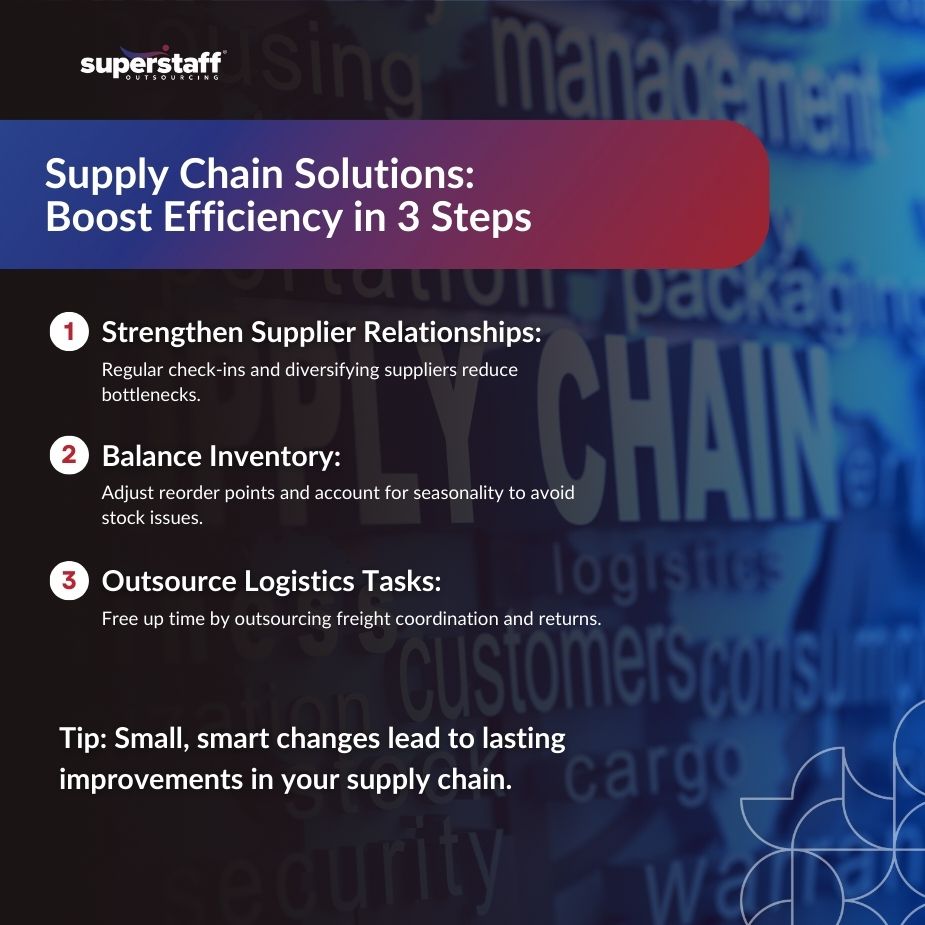
Managing a supply chain solutions involves constant challenges. Even minor disruptions can lead to delays, higher costs, and frustrated customers. Business leaders and operations managers know that every small inefficiency adds up, impacting both performance and profitability.
Improving your supply chain doesn’t always require a complete overhaul. Often, small, targeted changes can lead to significant improvements in efficiency and cost-effectiveness.
By focusing on key adjustments, you can reduce disruptions, enhance reliability, and create smoother operations. Let’s explore how making these changes can set you up for long-term success.

Reevaluate Supplier Relationships
Many supply chain issues stem from unreliable suppliers. They may deliver late, send the wrong quantities, or even fail to meet quality standards, all of which can cause significant disruptions. Research involving 352 suppliers revealed that poor supplier performance tends to result in more frequent and extended supply chain interruptions, ultimately affecting overall business performance.
What You Can Do:
It’s time to take a step back and reassess how you work with your suppliers. A solid supplier relationship is key to minimizing bottlenecks in the supply chain. Here are a few ways you can make improvements:
-
Regular Supplier Reviews
Conduct regular check-ins with your suppliers to assess their performance. Measure lead times, quality, and communication. This will give you a better understanding of which suppliers are consistently meeting your needs and which ones are causing delays.
-
Diversify Your Supplier Base
Having multiple suppliers for the same product or service can mitigate the risks of relying too heavily on one. A backup supplier can help you avoid delays if your main supplier faces issues. Diversification ensures you’re not left stranded when unexpected problems arise.
Once you’ve ensured your suppliers are reliable, the next step is optimizing your inventory to keep your operations flowing smoothly.
Optimize Inventory Levels
Too much inventory ties up capital, while too little leads to stockouts and lost sales. Effective inventory control is essential to well-rounded supply chain solutions.
What You Can Do:
Finding the right balance is key. Here’s how you can optimize your inventory levels:
-
Reassess Reorder Points
Your reorder points should reflect actual demand, not historical trends. Use your sales data to determine when to reorder and how much to keep in stock. By keeping just the right amount on hand, you can avoid excess stock while minimizing the risk of stockouts.
-
Account for Seasonal Trends
Seasonality affects demand. Plan ahead for holidays, peak shopping periods, or industry-specific busy times. Adjust your reorder points and safety stock levels accordingly.
While optimizing inventory is crucial, a significant source of logistical problems comes from repetitive tasks. Outsourcing certain functions can make a big difference.
Outsource Repetitive Logistics Tasks
As businesses grow, in-house teams may struggle to keep up with logistics workloads. Outsourcing certain tasks is one of the most cost-effective supply chain solutions available.
What You Can Do:
Consider outsourcing the following logistics functions:
-
Freight Coordination
Handling freight management in-house can be time-consuming and complex. By outsourcing it to a third-party logistics provider, you gain access to expertise and technology that can streamline the process.
-
Returns Handling
Managing returns can be a logistical nightmare, especially during peak times. Outsourcing this function to a specialized provider can ensure returns are processed quickly and accurately, reducing the burden on your internal team.
-
Customer Shipping Updates
Tracking customer shipments can take up a lot of time. A logistics partner can handle this efficiently, keeping customers informed and satisfied without requiring internal resources.
Now that your internal resources are freed up, it’s time to focus on creating a more predictable shipping schedule. Predictable shipping can reduce a lot of unnecessary stress. These services not only cut costs but also help build more dependable supply chain solutions through specialization.
Build More Predictable Shipping Schedules
A key to reducing chaos in your supply chain is consistency. Missed pickups, rushed orders, and warehouse overload often stem from unpredictable shipping schedules. The more you can predict and plan your shipments, the fewer surprises you’ll face.
What You Can Do:
Here’s how to create a more predictable shipping process:
-
Set Weekly or Biweekly Shipping Routines
Work with your logistics partners to establish a consistent shipping routine. A fixed schedule helps everyone involved know exactly when shipments are expected, making it easier to plan ahead.
-
Set Realistic Lead Times
Don’t rush orders or expect impossible turnaround times. Set reasonable lead times internally and work with your suppliers to ensure you can meet deadlines without cutting corners.
Predictable shipping is just one piece of the puzzle. Effective communication between departments is another key factor in minimizing supply chain issues.
Improve Communication Between Departments
Internal misalignment is a common cause of supply chain delays. When different departments don’t communicate effectively, it’s easy for orders to get lost, for shipments to be delayed, or for critical information to be overlooked.
What You Can Do:
Ensure that key departments involved in your supply chain — like procurement, logistics, and customer service — are aligned:
-
Weekly Check-Ins
Schedule regular check-ins between departments to keep everyone informed about the status of shipments, inventory, and upcoming orders. These meetings can help identify any issues early on before they become bigger problems.
-
Use a Shared Dashboard or Status Report
A shared platform allows everyone to access up-to-date information about orders, shipments, and inventory. This transparency improves communication and ensures all teams are on the same page.
Once communication is clear, it’s important to be prepared for the unexpected. Planning for disruptions in advance can keep your supply chain running smoothly even when surprises arise.
Plan for Disruptions in Advance
Supply chain disruptions are inevitable — whether it’s a shortage, a delay, or an external event like a port strike. The key is to be prepared so that these disruptions don’t derail your entire operation.
What You Can Do:
-
Develop Contingency Plans
Create backup plans for key suppliers, carriers, or even entire shipping routes. Knowing what to do in advance allows you to respond quickly when problems arise.
-
Keep Backup Resources Ready
Having a backup warehouse or carrier in your network can help you avoid costly delays when your main resource is unavailable. Being able to pivot quickly can save time and money.
Smarter Supply Chains Start with the Right Support
Running an efficient supply chain doesn’t have to be overwhelming. Small, strategic changes—such as reassessing supplier relationships, improving inventory control, outsourcing repetitive tasks, and strengthening team coordination—are effective steps to optimize your supply chain for better performance. These adjustments can help reduce delays, control costs, and improve overall operational flow.
Finding the right supply chain solutions is essential to maintaining long-term efficiency and scalability. SuperStaff provides tailored outsourcing support for logistics, back-office tasks, and customer service, helping businesses resolve operational pain points and strengthen supply chain performance.
If you’re ready to improve how your supply chain runs, now is the time to act. Let SuperStaff support you with reliable supply chain solutions that simplify processes and drive better results.






